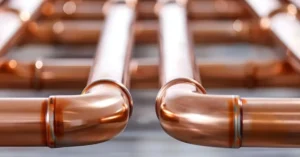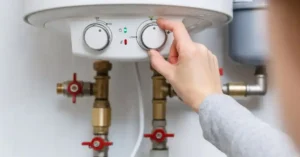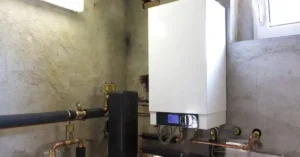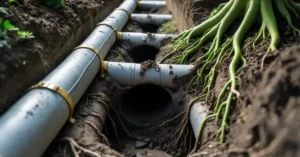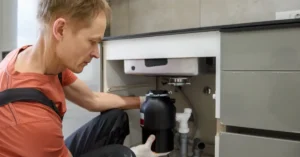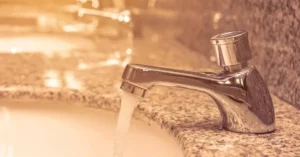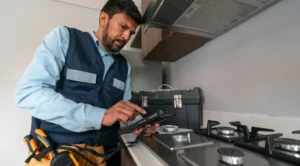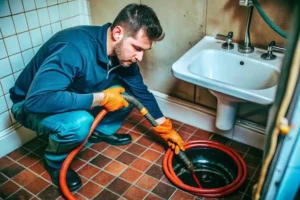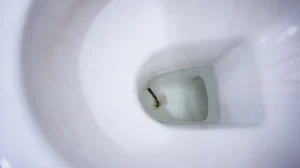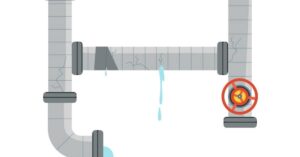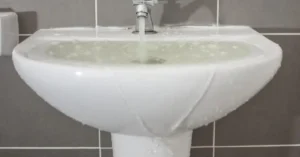Finding tiny, dark specks hopping near your sink or shower can be unnerving. These creatures are likely springtails, and while harmless, they signal a critical issue in your home. Their presence points directly to excessive moisture, especially in a high-humidity room like the bathroom. This article will show you step-by-step how to get rid of springtails in bathroom and prevent their return.
We will share the expert strategies necessary to eliminate these persistent pests permanently. By focusing on moisture control the true source of the problem you can stop a springtail infestation and protect your home’s structure.
What are Springtails?
Springtails are small, wingless insects belonging to the order Collembola. They are tiny, usually only 1 to 5 millimeters long. They do not bite or sting people or pets. Springtails are often misidentified because of their most defining feature: their incredible jumping ability.
They possess a tail-like appendage called a furcula tucked under their abdomen. When startled or sensing a threat, they release the furcula, propelling themselves into the air. Outdoors, they are beneficial, breaking down organic matter. Indoors, they are a nuisance pest that thrives only in damp environments.
What are the Small Jumping Bugs in My Bathroom?
If you spot tiny jumping bugs in your bathroom, you’re likely dealing with springtails. These creatures look like dark pepper specks scattered across white surfaces. They range in color from white and gray to dark brown or black.Springtails differ from other bathroom pests in several ways. Unlike fleas, they don’t bite humans or pets. They’re smaller than most ants and don’t form visible trails. Drain flies have wings and hover around drains, while springtails jump and walk.The jumping behavior is your biggest clue. When you turn on the bathroom light or approach the sink, these bugs suddenly leap in different directions.
This startled response comes from their furcula activating.You’ll find these bugs near water sources. Check around your bathtub, shower drain, toilet base, and under the sink. They gather in grout lines, bathroom tiles, and anywhere moisture collects. If you have bathroom plants, inspect the soil too.
Signs of Springtail Infestation in Your Home
A springtail infestation shows specific warning signs. The most obvious is seeing clusters of these insects in damp areas. During heavy infestations, you might count hundreds or thousands in a single bathroom.
Look for these key indicators:
Your bathroom walls show water stains or discoloration. This suggests moisture problems behind the surface where springtails breed.
You notice a musty smell in your bathroom. This odor often means mold growth, which provides food for springtails.
Grout lines between tiles appear darker or stained. Springtails hide in these cracks during the day.
Your shower curtain or bath mat stays damp for hours after use. Constant moisture creates ideal springtail habitat.
Window sills in your bathroom have small dark specks that move. Springtails migrate to windows seeking light.
After rain or snow melts, you see more bugs appearing. Weather changes drive outdoor springtails inside seeking shelter.
The white card test reveals hidden populations. Place a white index card on your bathroom floor overnight. Check it in the morning for tiny jumping bugs.
How to Get Rid of Springtails in Your Bathroom
Getting rid of springtails requires a two-step approach. First, remove existing bugs. Second, eliminate the conditions that let them survive.
Immediate Removal Methods
Start with a vacuum cleaner. Suck up all visible springtails from your bathroom surfaces. Empty the vacuum bag or canister outside immediately. This prevents bugs from crawling back out.Create a soapy water spray for springtails extermination. Mix two tablespoons of dish soap in a quart of water. Spray this solution directly on springtails. The soap breaks down their protective coating and kills them within minutes.Many homeowners ask, does vinegar kill springtails? Yes, it works effectively.
Mix equal parts white vinegar and water in a spray bottle. Apply this mixture to bathroom tiles, grout, and around drains. The vinegar’s acidity disrupts their bodies and eliminates organic matter they feed on.For what kills springtails instantly, try rubbing alcohol. Fill a spray bottle with 70% isopropyl alcohol. Spray directly on bugs for immediate results. This method works well for small groups you spot during the day.
Deep Cleaning Your Bathroom
Clean all bathroom surfaces with bleach solution. Mix one part bleach with ten parts water. Wipe down your sink, tub, and tile surfaces. This removes mold, algae, and other food sources.Scrub your bathroom grout thoroughly. Old toothbrushes work well for reaching between tiles. Clean grout removes springtail hiding spots and eliminates their food supply.Clear out drain pipes using hot water and baking soda. Pour half a cup of baking soda down each drain, followed by hot water. This flushes away organic buildup where springtails breed.
Moisture Control Strategies
Fix all water leaks immediately. Check under your sink, around the toilet base, and behind the shower. Even small drips create enough moisture for springtail populations.Install a bathroom exhaust fan if you don’t have one. Run it during showers and for 30 minutes after. This removes humidity that springtails need to survive.Use a dehumidifier in your bathroom. Keep humidity levels below 50%. You can buy an inexpensive hygrometer to monitor moisture levels.Improve air circulation by leaving your bathroom door open when not in use.
Better airflow helps surfaces dry faster.Seal cracks and gaps around pipes, baseboards, and tiles. Use waterproof caulk to close entry points. This prevents outdoor springtails from getting inside.
Natural Solutions
Diatomaceous earth provides chemical-free control. Sprinkle food-grade DE around your bathroom’s edges and under the sink. This powder damages springtail exoskeletons, causing dehydration. Replace it weekly since moisture reduces its effectiveness.Cedar oil spray repels springtails naturally. Mix 20 drops of cedar essential oil with water in a spray bottle. Apply to bathroom surfaces as a preventive measure.
When to Use Chemical Treatments
For severe springtail infestation, consider targeted insecticides. Pyrethroid sprays work for bathroom perimeters and wall voids. Apply these products in cracks around pipes and behind cabinets.Aerosol insecticides help reach tight spaces. Spray into wall cracks, around drainpipes, and under bathroom fixtures. Follow product instructions carefully and ventilate the room.Remember that chemicals only provide temporary relief. Without fixing moisture issues, springtails will return within weeks.
You can read about: Worm in Toilet Bowl
How to Prevent Jumping Bugs in Your Bathroom
Prevention keeps springtails from returning after you get rid of springtails. Make these changes part of your regular bathroom maintenance routine.
Dry your bathroom completely after each shower. Wipe down walls, doors, and surfaces with a towel. This simple habit removes moisture before springtails can move in.
Wash bath mats and shower curtains weekly. These items trap moisture and provide perfect springtail breeding grounds. Use hot water and dry them thoroughly.
Keep bathroom cleaning products in sealed containers. Springtails can access moisture from cleaning solution residue left on bottles.
Store toilet paper and towels in closed cabinets. This prevents them from absorbing bathroom humidity.
Check your bathroom pipes monthly. Look for condensation on pipes, water stains, or dripping fixtures. Catch moisture problems early before springtails appear.
Remove bathroom plants or reduce watering. If you keep plants in your bathroom, let the soil dry between waterings. Consider moving them to less humid rooms.
Clean your bathroom exhaust fan every three months. Dust and debris reduce its efficiency, allowing moisture to build up.
Maintaining a Springtail-Free Environment
Long-term success requires consistent habits. Monitor your bathroom humidity with a digital hygrometer. These devices cost less than $15 and help you track moisture levels.
Schedule deep bathroom cleaning every two weeks. This regular attention prevents organic matter buildup that feeds springtails.
Inspect bathroom caulking twice yearly. Replace cracked or missing caulk around tubs, showers, and sinks. Fresh caulk prevents water from seeping into walls.
Test your bathroom for hidden leaks. Turn off all water in your home and check your water meter. If it moves, you have a leak somewhere that needs fixing.
Consider professional plumbing inspection annually. Licensed plumbers can detect moisture problems you might miss. They check behind walls and under floors where springtails breed.
Keep your bathroom well-lit. Springtails prefer dark, damp spaces. Better lighting discourages them from settling in your bathroom.
Apply monthly vinegar for springtails prevention. Spray a light vinegar solution around drains and in corners. This maintains an environment springtails avoid.
Why Choose Derks Plumbing
Bathroom moisture problems often start with hidden plumbing issues. Leaking pipes behind walls, failing wax rings under toilets, or condensation from poor ventilation create perfect springtail habitat.
Professional plumbers identify water sources you can’t see. We use moisture meters and thermal imaging to locate hidden leaks. Our team fixes the root cause, not just the symptoms.
Derks Plumbing brings years of experience to every bathroom moisture problem. We understand how plumbing systems contribute to pest issues. Our repairs prevent future infestations while protecting your home from water damage.
We offer comprehensive bathroom inspections that cover all moisture entry points. From pipe connections to drainage issues, we ensure your bathroom stays dry and pest-free.
Conclusion
Successfully solving how to get rid of springtails in bathroom hinges entirely on controlling moisture. By addressing hidden leaks, reducing humidity, and modifying their habitat, you can eliminate the source of the infestation. If you require expert moisture assessment or repair to solve recurring springtail issues, contact Derks Plumbing today for reliable Plumbing Services in Los Angeles. We are here to help you achieve a dry, springtail-free home environment.
FAQ's
Q: How fast can I get rid of springtails?
You can see significant population reduction within days of combining aggressive vacuuming, soapy water treatment, and immediate dehumidification. Full elimination of the springtail infestation usually takes 2–4 weeks once the root moisture problem is permanently fixed.
Q: Will springtails eventually go away on their own?
No, they rarely disappear completely. They may temporarily decline during dry periods, but they will return once moisture levels rise again. Permanent removal requires active intervention to get rid of springtails by eliminating their water source.
Q: What is the best product for springtails extermination?
The best “killer” is a dehumidifier, but for residual control, perimeter sprays containing bifenthrin or pyrethroids are effective outdoors. Indoors, Diatomaceous Earth or a contact spray is often sufficient once the moisture is under control.
Q: Can I use vinegar to kill springtails?
Yes, vinegar for springtails works well as a contact killer. A mixture of equal parts white vinegar and water can kill them instantly by disrupting their skin. However, using vinegar for springtails is only a temporary fix and does not solve the underlying moisture issue.
Can I prevent springtails permanently?
Yes, permanent prevention is possible through moisture management. Keep bathroom humidity below 50%, fix all leaks promptly, and maintain good ventilation. Regular cleaning removes their food sources. These habits create an environment where springtails cannot survive.


